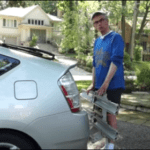There are many kinds of cycling trips. You may wish to follow in the spandex clad trails of the Tour de France, or opt for a fully catered five-star guided tour. That is not how my partner Kim and I roll. We look for non-challenging rides averaging 50 kilometres per day where we can set our own pace and choose our own times and places to stop.
A version of this story appeared in The Toronto Star on March 5, 2015
These are typically described as self-guided. The tour operator provides bikes, maps and directions, hotels with breakfast and arranges for your luggage to be transferred from hotel to hotel. There is support if you have an emergency, bike or otherwise.
If 50 kilometres per day sounds daunting, let me break it down. We set out about nine, with a stop for coffee or sightseeing when the mood strikes us. Around noon we stop at an interesting town or an appealing cafe.
After a leisurely and typically scenic lunch, we’ll explore the town before setting off again about 3 PM. A total of four to five hours riding, averaging 12-15 kilometres per hour – an easily manageable pace for anyone with a reasonable fitness level.
The self- guided tours we’ve taken typically include overnight accommodation, breakfast and luggage transfers from one hotel to the next. There are many tour organizers, some serving specific areas, other that cover the world.

The tour operator we selected for this trip, Rad & Reisen (www.radreisen.at) , offers a variety of Danube packages, including different distances, durations and options for higher class hotels or the occasional boat or train trip to break up the cycling. Prices are reasonable – figure about $1,000 per person for a week’s trip. Lunches, dinners and other incidentals are not included.
We started in Passau, at the German border and cycled to Vienna.
There was more rain than we expected. In fact, it started raining as soon as we’d picked up our bikes from the depot. We tried to wait it out, but eventually made a dash for the hotel outfitted with light weight rain covers provided by the helpful bike rental agent.
We were still trying to wait out the rain the next morning. We made it to the shopping centre in Passau, and upped our rain gear to mange the conditions. The guide book had said that there was a ferry that operated between Passau and Niederanna, our first night’s stop. The boat left at noon – and that meant we had to make a decision. How wet would wet get if we tried to ride?
I opted to take the boat, a decision Kim did not support. The boat dropped us at the wharf directly in from of the Gasthof drawler in Niederanna, our first hotel. By the time we’d put our suitcases in the room, it was dry enough to ride. We took the trail about 15km back towards Passau and returned to the hotel.
Breakfasts are included, but we’re on our own for dinner. Niederanna proved to be a very quiet town, so dinner at the hotel was our only option. We started with a glass of wine on the patio in the last rays of sun. After dinner we studied the guidebook to see what the next day’s attractions would be along the trail.
After breakfast we went around the Schlongen loop, where the Danube does a 180 degree turn. We stopped at a small cafe and enjoyed a freshly smoked trout – steckerlfish. We took ferries back and forth from one side to the other and ended in Linz, a modern vibrant city – which offered far more than we had time to enjoy.
Checking the guidebook that evening, we noticed that our next day’s ride would take us past the memorial at the former Mauthausen concentration camp. I wasn’t too keen on going.
After checking out, we stopped for a slice of Linzertort and made our way back to the path. We stopped at the turnoff to Mauthausen, and met Jeremy, another cyclist who’d we’d met several times over the last two days. He highly recommended taking a tour, so we puffed and panted our way up the 14 degree incline.
Our hotel in Grein was a few kilometres uphill, into the mountains that surround the Danube, and they ferried us up the eight kilometre climb to Bad Kreuzen, a scenic hamlet. Before dinner we hiked up to Kreuzen castle.
That gave the next day a 15 minute downhill ride to start. We hadn’t seen Grein, so stopped to look at the oldest original town theatre in Austria. We found lunch on the picturesque town square in Ybbs, and continued to Pochlarn. Our hotel informed us that they didn’t have a room for us, but instead were providing alternate accommodations in a bed and breakfast in the city centre.
From Pochlarn, it’s a few kilometres to Melk, where an enormous abbey overlooks the town and river.
From Melk we entered into the Wachau, which is known for fruit (primarily apricots and cherries) and wine. On a Sunday the tasting bars were not open, but the town of Durnstein a charming tourist village was busy with weekend visitors.
Our last day started with a non-mandatory train ride, to reduce the riding distance to Vienna.




